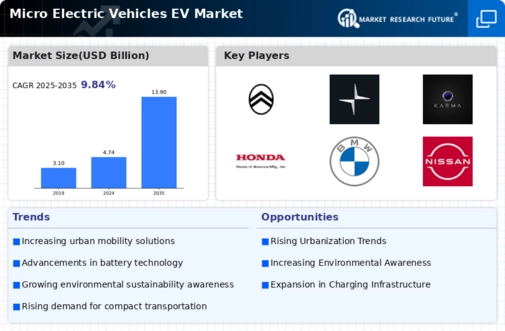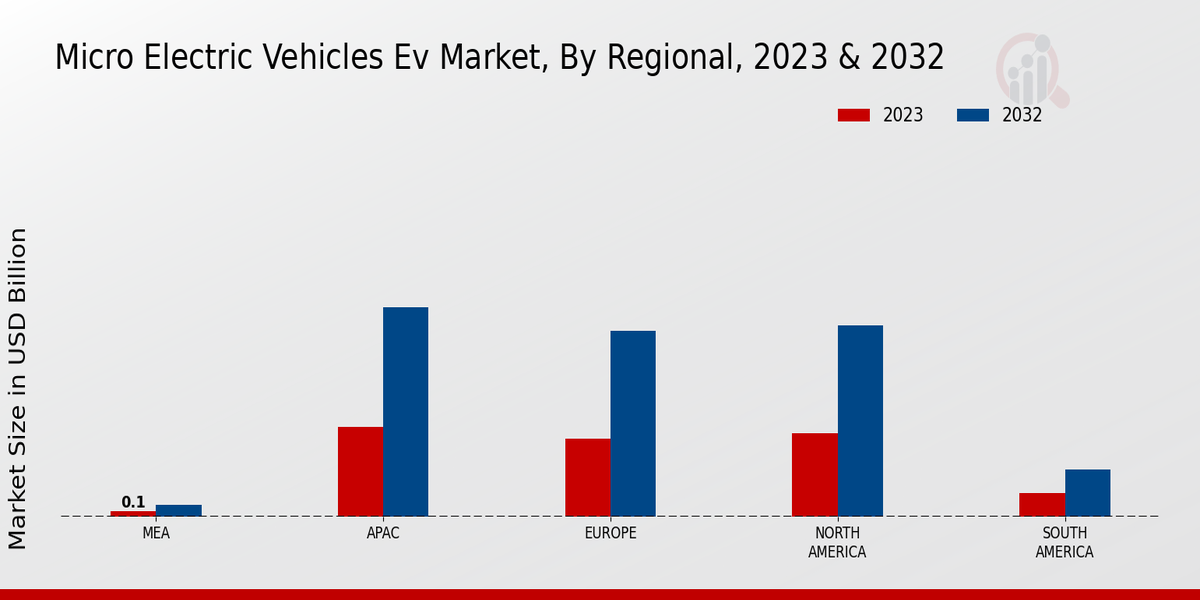Cost-Effectiveness
The cost-effectiveness of micro electric vehicles is a significant factor influencing the Global Micro Electric Vehicles EV Market Industry. As production costs decrease and economies of scale are realized, the affordability of these vehicles improves. Additionally, lower operating costs, such as reduced fuel expenses and maintenance, make micro EVs an attractive option for consumers. For example, cities that offer incentives for electric vehicle purchases further enhance their affordability. This trend is expected to drive market growth, as more consumers recognize the long-term savings associated with micro electric vehicles, contributing to the anticipated market value of 4.74 USD Billion in 2024.
Growing Urbanization
The rapid pace of urbanization globally is a crucial driver for the Global Micro Electric Vehicles EV Market Industry. As cities expand, the demand for compact, efficient transportation solutions increases. Micro electric vehicles, with their small footprint and low emissions, are well-suited for congested urban environments. For instance, cities like Amsterdam and Tokyo have seen a surge in micro EV adoption, as they offer a practical alternative to traditional vehicles. This trend is expected to contribute to the market's growth, with projections indicating a market value of 4.74 USD Billion in 2024, reflecting the increasing need for sustainable urban mobility.
Environmental Regulations
Stringent environmental regulations imposed by governments worldwide are propelling the Global Micro Electric Vehicles EV Market Industry. As nations strive to meet climate goals, policies promoting electric mobility are becoming more prevalent. For example, the European Union has set ambitious targets for reducing carbon emissions, which encourages the adoption of micro electric vehicles. These regulations not only incentivize consumers but also compel manufacturers to innovate and produce cleaner alternatives. Consequently, the market is anticipated to grow significantly, with a projected CAGR of 10.28% from 2025 to 2035, as more countries implement supportive frameworks for electric mobility.
Market Growth Projections
The Global Micro Electric Vehicles EV Market Industry is projected to experience substantial growth over the coming years. With a market value expected to reach 4.74 USD Billion in 2024 and further expand to 13.9 USD Billion by 2035, the industry is poised for a remarkable trajectory. The anticipated CAGR of 10.28% from 2025 to 2035 underscores the increasing demand for micro electric vehicles as urbanization, environmental regulations, and technological advancements converge to create a favorable landscape for electric mobility. This growth reflects a broader shift towards sustainable transportation solutions globally.
Technological Advancements
Technological advancements in battery technology and electric drivetrains are enhancing the appeal of micro electric vehicles, thereby driving the Global Micro Electric Vehicles EV Market Industry. Innovations such as improved battery efficiency and reduced charging times are making these vehicles more practical for everyday use. For instance, advancements in lithium-ion batteries have led to longer ranges and faster charging capabilities, which are critical for consumer acceptance. As technology continues to evolve, it is likely that the market will expand, with estimates suggesting a market size of 13.9 USD Billion by 2035, reflecting the growing consumer confidence in micro EVs.
Consumer Awareness and Acceptance
Increasing consumer awareness and acceptance of electric mobility solutions are pivotal in shaping the Global Micro Electric Vehicles EV Market Industry. As environmental concerns rise, consumers are becoming more informed about the benefits of micro electric vehicles, including their reduced carbon footprint and operational efficiency. Campaigns promoting sustainable transportation options have also played a role in changing perceptions. This growing acceptance is likely to drive demand, as evidenced by the increasing sales figures in regions with strong awareness initiatives. The market is poised for growth, with projections indicating a significant rise in adoption rates as consumers seek eco-friendly alternatives.















